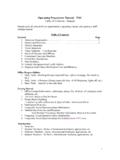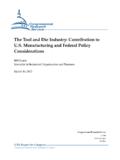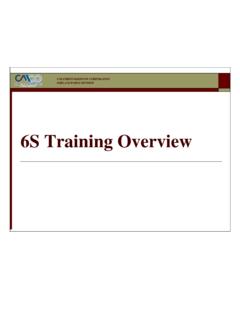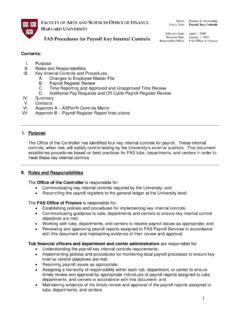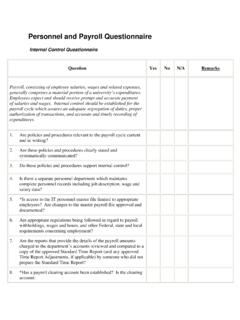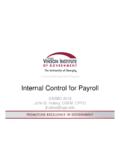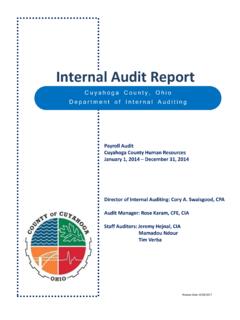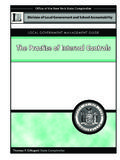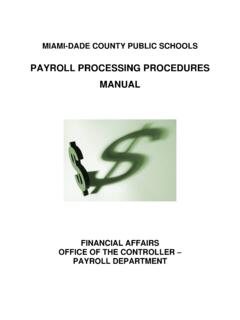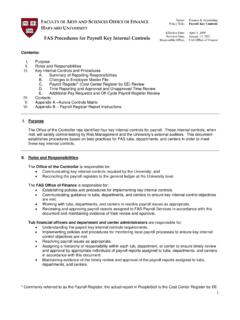Transcription of INTERNAL ACCOUNTING CONTROLS CHECKLIST FOR NTMA …
1 INTERNAL ACCOUNTING CONTROLS CHECKLIST FOR NTMA CHAPTERS Presented at NTMA 2004 Annual Convention Palm Springs, CA February 2004 National Tooling & Machining Association 9300 Livingston Road Ft. Washington, MD 20744 P R E C I S I O NInternal ACCOUNTING CONTROLS CHECKLIST Summary A fundamental principle of INTERNAL control is to segregate duties so that no one person has the ability to initiate, execute, record, and reconcile a transaction from beginning to end. Bond all ACCOUNTING employees and others who handle cash receipts, make deposits, have access to securities, responsible for purchasing, and wire transfers. Require mandatory vacations ( two consecutive weeks if possible) for the above personnel. Cross train employees so that someone else does the job during the vacation. Require purchases and sales of securities to be authorized by the board of directors, an executive, or other appropriate party.
2 Use a For Deposit Only endorsement stamp on all checks upon receipt. Make all deposits intact daily and use multi-part deposit slips. Reconcile bank accounts monthly. Have the Director or manager review the reconciliation. Require written supervisory approval for write-offs, credit memos, employee additions, terminations, and wage changes, and before customer/members are added to or deleted from the master file. Attach permanent identification tags to fixed assets and maintain detailed records. Use physical or software CONTROLS to prevent unauthorized access to ACCOUNTING systems. Use prenumbered purchase orders, multi-part checks, and debit/credit memos. Periodically verify that their sequence is accounted for. Use competitive bidding. Require two signatures for all checks. Limit authorized signors to corporate officers or employees who are independent of the initiator of purchases, approver of purchases, receiving, shipping, preparer of checks, cash receipts, accounts payable, and cash bookkeeping.
3 All back up documentation including the original invoice should accompany the check when sent for signature. Require bank callback verifications for telephone transfers exceeding a predetermined dollar amount. (Review the transfer activity on the bank statement and look for transfers just under this dollar limit.) Ensure that wire transfers are subject to the CONTROLS over other disbursements (such as requiring original invoices and passwords). Require time sheets for all employees. Subject these to review and approval by supervisors. Use a separate imprest bank account for payroll. Deposit only the amount needed to cover the actual payroll for the period. Never sign blank checks. Prohibit checks written to cash or bearer . Establish policies for employee expense reimbursement and require employees to submit original receipts for reimbursement. Investigate deviations from the policy. Require review and approval of expense reports before they are paid.
4 Check signers should not approve their own expense reports. Use monthly budgets and investigate significant variances. Pay particular attention to projects with excessive costs. INTERNAL ACCOUNTING CONTROLS CHECKLIST INTERNAL ACCOUNTING control is a series of procedures designed to promote and protect sound management practices, both general and financial. Following INTERNAL ACCOUNTING control procedures will significantly increase the likelihood that: financial information is reliable, so that managers and the board can depend on accurate information to make programmatic and other decisions assets and records of the organization are not stolen, misused, or accidentally destroyed the organizations policies are followed government regulations are met. The following is a listing of basic CONTROLS that you may wish to use to review your INTERNAL ACCOUNTING CONTROLS and determine which areas require further improvement. Cash/Accounts Receivable Have an employee independent of billing, accounts receivable, and cash handling investigate customer/member complaints.
5 Compare current cash receipts volumes to historical or expected cash receipts volumes. Post a toll-free number to which employees and members can make complaints. Separate the duties of opening daily receipts, preparing deposits, making the deposit slips recording payments, and originating noncash credits to customer/member accounts. Use a For Deposit Only endorsement stamp on all checks upon receipt. Separate responsibility for cash receipts, accounts receivable, and cash disbursements from responsibility for reconciling the bank statement. Make all deposits intact daily. (The employee making the deposit should not be the cashier or work in accounts receivable.) Consider using a lockbox for large volume cash receipts. Maintain cash receipts separately from cash funds. Keep undeposited amounts in a safe. Have someone not involved in making the bank deposit open the daily mail, count the cash and check amounts received, and prepare a list of daily cash receipts.
6 The list should be compared to the amount deposited and the customer/member account postings by someone independent of cash receipts and accounts receivable. Have the Director/manager or another appropriate person review the bank records each month. A Director/manager or other appropriate person should make independent comparison of deposits on bank statements to general ledger postings and validated deposit slips. Cash/Accounts Receivable (cont d) Use multi-part deposit slips and compare the amount on the in-house copy to the amount deposited on the bank statement. Rotate personnel who have physical custody of daily receipts. Minimize the amount of petty cash kept on hand. Lock up the petty cash fund. Require original receipts to support petty cash disbursements and review them closely. Reconcile and replenish petty cash monthly. Have someone not involved in making the bank deposit or accounts receivable bookkeeping open the daily mail, count the cash and check amounts received, and report those totals to the Director/manager or another appropriate person, who compares the reported amount to the amount actually deposited.
7 Have the person who opens the mail use a for deposit only endorsement stamp on the back of each check received. Separate the duties of preparing the deposit slip from making the deposit. Reconcile all bank accounts monthly, with review by the Director/manager or another appropriate person. Have someone outside the ACCOUNTING function review the detailed bank reconciliation documentation and any adjusting entries made to the books. Use multi-part deposit slips. (One copy should be reviewed and maintained by someone other than the employee who completed it.) Compare current cash receipts volumes to historical or expected cash receipts volumes. Regularly reconcile the accounts receivable general ledger balance to the subsidiary ledger, with appropriate supervisory review and follow-up. Prepare an aged trial balance and have someone other than the person posting accounts receivable call customer/members to follow-up on delinquent accounts.
8 Require mandatory vacations for all personnel in accounts receivable and cash handling functions. Vacations should be least two weeks long and occur at the end of an ACCOUNTING cycle. Cross train employees so that someone else does the job during the vacation. Require supervisory approval before customer/members are added to or deleted from the master file. Have someone independent of the preparer of the daily deposit list, cash handling, billing, and accounts receivable bookkeeper investigate customer/member complaints and billing questions. Bond the employees who handle the cash receipts and make deposits. Separate receivables collections from receivables recordkeeping. Accompany each write-off with a final letter demanding payment. (If the customer/member already paid the bill, he or she will complain.) Separate duties for maintaining the accounts receivable subsidiary ledger and the general ledger. Cash/Accounts Receivable (cont d) Have a manager without responsibility for the ACCOUNTING function, review allowances for doubtful accounts, sales returns, and open account balances based on his or her knowledge of the account s history.
9 Have a manager review the aging reports each month for unusual items, making sure the aging report agrees to the general ledger. Separate the duties for billing and shipping from cash and accounts receivable bookkeeping. Require written supervisory approvals for write-offs and credit memos. Investment Securities Separate responsibility for securities from the cash receipts and cash disbursement functions. Separate the duties of authorizing transactions, making trades, maintaining custody of assets, and recordkeeping. Restrict custodial responsibility for securities and other valuable documents to authorized personnel. Maintain authorized lists of signators and securities dealers, and update those lists periodically. Require employees with investment responsibilities to take at least two week vacations, and require other employees to perform those functions in place of the absent employee. Require purchases and sales of securities to be authorized by the board of directors, a corporate executive, or other appropriate party.
10 When possible, maintain securities at a brokerage firm in their street name. If securities are held by the organization, they should be held in the name of the organization unless they are bearer bonds. Keep the securities under dual control in a safe or safe deposit box rented in the organization s name. Maintain an up-to-date list of authorized securities dealers. Maintain an up-to-date list of all securities held by the organization, including a detailed description (with cusp and certificate numbers). Limit entry to the safe or safe deposit box to only instances when there are two or more designated representatives present. Maintain a record of all visits to the safe or safe deposit box. Have someone who is independent of securities trading and custody periodically count or confirm the securities and reconcile the information to the general ledger. Have the Director/manager review the reconciliation of the securities count to the general ledger.
